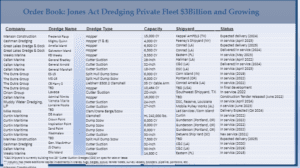By Dredging Contractors of America.
As the U.S. Jones Act private sector dredging industry continues with its $3 Billion construction of new dredges and associated vessels and equipment, the Dredging Contractors of America is pleased to announce the results FY 2023 dredging season as reported in the U.S. Dredging Report: An Analysis of the FY23 U.S. Federal Dredging Market.*
The highly competitive American dredging industry had fifty-six (56) different companies who were awarded U.S. Army Corps of Engineers work in FY23 – with twenty-one (21) large and thirty-four (34) small businesses being awarded federal dredging projects.
The total awards amounted to nearly $2.1 Billion – a thirty-nine percent (39%) increase from FY22; twenty percent (20%) above the seven-year average of $1.7 Billion; with FY23 capturing highest award year on record.
“The private sector U.S. dredging industry continues to be highly competitive, innovative and saves the country hundreds of millions in tax payer dollars,” said William P. Doyle, Chief Executive Officer of the Dredging Contractors of America. “The industry is recapitalizing its fleet of dredges and equipment and helping the Army Corps of Engineers meet its 70% goal of reusing dredge material for beneficial projects like shoreline stabilization, barrier island restoration, and securing fish and wildlife habitat.”
Solicitations
The industry low bid compared to the Government Estimate (GE) and Government Estimated Awardable Range (GEAR) accounts for the following:
- 135 of the 163 projects have available industry bid/GE comparisons and were not sole-sourced: eighty (85) of the 135 (63%) had a winning bid lower than the GE; and 126 of the 135 (93%) had a winning bid lower than the GEAR.
- Of the eighty-five (85) projects where industry was lower than the base GE, sixty-three (63) projects were cheaper by more than ten percent (10%); thirty-two (32) projects by more than twenty-five percent (25%); eleven (11) by more than forty percent (40%); and four (4) by more than fifty percent (50%).
- The savings to the United States is $707,332,283. This is an average savings of tax payer dollars of thirty-five percent (35%) per project when compared to the GEAR.
Competition
With respect to the competitiveness of the U.S. dredging industry, there was an average of three (3) bidders on unrestricted projects and small business set-aside projects. Additionally, there was an average of three (3) bidders on hopper dredge projects.
Beneficial Use of Dredged Material
Reusing dredged material excavated from the seafloor, river and lake bottoms is known as beneficial use of dredged material. Such uses include rebuilding barrier islands, fish and wildlife habitat creation and restoration, beach nourishment, landfill cover, human recreation and land site remediation. Beneficial use of dredged material in a harbor can have a significant impact on improving the condition of the harbor while also alleviating existing demand for development and use of new disposal sites.
The Army Corps of Engineers has a set a goal of reusing 70% of dredged material for beneficial uses by 2030.
In FY23, sixty-six percent (66%) of the overall federal dredging program totaling 107 projects incorporated the use of dredged material for beneficial purposes, compared to fifty-nine percent (59%), a total of eighty-seven (87) projects in FY22.
The U.S. Dredging Industry’s $3 Billion Recapitalization Matrix

*Data compiled in this report has been obtained from federal project data found on SAM.gov, the U.S. Army Corps of Engineers’ Dredging Information System (DIS), and provided by U.S. dredging companies. U.S. Dredging Report: An Analysis of the FY23 U.S. Federal Dredging Market by Michael Gerhardt, Summer 2024.

